The catalog records that a library user sees in the course of searching often belie a considerable underlying complexity. At AAS, maximizing access to our collections through the creation of accurate, clear and concise catalog records is a high priority. However, the true extent of the effort required to create and maintain these records may not be readily apparent from their often brief and streamlined appearance.
One very particular aspect of this work that users of the online catalog may understandably not think much about is name authority control. The creation of a unique access point (or “heading”) to represent each individual whose name appears in a catalog record is important no matter who they are or what their role might be. Although authors, editors, booksellers, printers, publishers, artists, engravers, illustrators, lithographers, and the personal subjects of works might spring to mind most readily, other associated persons for whom we routinely create access points include dedicatees, translators and the former owners of AAS copies.
For well-known persons either living or dead (and even for some not so well-known), coming up with a unique access point might not be much of a challenge if they have been clearly documented in the collective historical record. But for others, especially the vast majority of the often-elusive historical figures who are of interest to us at AAS, devising a unique access point can be a circuitous and sometimes frustrating journey.
Basically, the goal of name authority control is three-fold: the first is establishing an individual’s identity clearly and unambiguously; the second is determining exactly what the form of the name ought to be; and the third is formulating some sort of qualifier—ideally birth and/or death dates—to differentiate the individual from others who may have the same name. The presence of vital dates in an access point also helps to situate a person within a particular historical context and increases the likelihood that users of the catalog will be able to zero in on what they are looking for as efficiently and quickly as possible.
One such elusive person who came to our attention recently was a Charles C. Green, whose proposal to publish “a series of anti-slavery designs . . . to be called, The Nubian slave” appeared in the March 14, 1845 issue of The Liberator, William Lloyd Garrison’s Boston-based abolitionist newspaper. In the prospectus, Green explains that the work will include seven lithographs, each complemented by a poem designed to unite the whole, and that he believes the “application of pictorial art to moral truth is capable of producing a great, and, as yet, almost untried force, which the friends of human freedom have now an opportunity to test.” Green himself was both artist and poet.
The Nubian slave was soon published in Boston by Bela Marsh, and its stark depiction of an African family as its members are brutally enslaved elicited immediate comment. The first image shows the family living in freedom in Africa, but the others present an unflinching view of the father, mother and their small son as they are auctioned, sold, branded, and hunted down after attempting to escape. On June 11, 1845 the Emancipator and weekly chronicle included a staunchly positive review:
“All these horrid facts, the existence of which we all know, and to hide which baptized sophistry has for these hundreds of years been bestowing its paint and varnish and fig leaves, Mr. Green has made to stand out in living reality upon his page. He shows not only what they are, but how they are. With a genius that can transfer to a simple surface of white paper the lineaments and living expression of god-like humanity, he shows us its deep passions, while it undergoes the varied torture of being brutalized at the behest of Mammon, Moloch, Belial & Co. These passions, truly expressed, must awaken sympathy. They must. That is the eternal God’s decree. Let them be placed before every free American, and then let him decide, in view of the last picture of the poor fugitive, with his dead wife on his arm, battling with a pack of hounds and receiving the balls of a company of slaveholders, as if he were a wild beast, which side he will take in this war. He cannot look at this picture and not know which side God takes.”
The lithographs may also have served as inspiration for Henry Box Brown’s Mirror of Slavery, a moving panorama created by Henry Box Brown. An enslaved man from Louisa County, Virginia, Brown escaped in 1849 by having himself shipped in a box from Richmond to Philadelphia. He eventually made his way to Boston and exhibited the panorama in New England for several years until moving to Great Britain following the passage of the Fugitive Slave Act in 1850.
But what about Charles C. Green himself? Aside from the fact that he had created what was clearly a transformative work, few personal details about him and his life had thus far been unearthed, even though AAS acquired a copy of The Nubian slave many years ago.
A cursory review of the online catalogs of institutions holding the few other extant copies of Green’s work reveals no further clues. Bibliographies can often provide useful information, but The Nubian slave is not recorded in Wright Howes’ U.S.iana (1650-1950), Joseph Sabin’s Dictionary of books relating to America from its discovery to the present time, or in the Catalogue of the Charles L. Blockson Afro-American collection. Although it is included in Checklist of American imprints for 1845, the entry includes no additional clues to Green’s identity. Green is not listed in the Getty Research Institute’s Union List of Artist Names, nor in Who was who in American art. This is precisely the sort of puzzle that catalogers find so tantalizing, and at AAS we are committed to creating bibliographic records that provide as much relevant information about the people associated with the items in our collections, as they do about the items themselves. In the case of Charles C. Green, however, extra tenacity would be required.
Initially, all that was generally known about the creator of The Nubian slave was that he had been an abolitionist in Boston in the 1840s. Databases like Ancestry contain massive amounts of information and can be overwhelming, particularly when seeking someone with a fairly common name, so the general approach in such cases is to start with census records. The 1850 U.S. Federal Census was the first to include the occupations of persons, so that seemed like a good place to begin. Although that census included several persons named Charles C. Green, one in particular stood out. Charles C. Green, a 31-year-old portrait painter, was listed as a resident of Canandaigua, N.Y. who had been born in Massachusetts. He remained in Canandaigua for at least another fifteen years and appeared in both the 1860 U.S. Federal Census and the 1865 N.Y. State Census, classified as an artist in each of these. He was not listed in any census after 1865. His wife Emily Green is listed in the 1870 U.S. Federal Census, along with their three daughters (Edith, Susan and Mary), and is identified as divorced. As intriguing as this information was, however, it still did not connect back to Boston and The Nubian slave.
A few targeted Google keyword searches then led to several valuable sources that would likely have remained hidden had they not been scanned and available for searching. The first was a digitized periodical called the Sandspur (produced by the students of Rollins College). In an issue from November 7, 1934, there was a reference to an artist named Charles Chauncey Green, described as a friend of Nathaniel Hawthorne and Margaret Fuller, a Brook Farm resident and one of the first U.S. muralists. This seemed promising even though there was no mention of The Nubian slave.
Another Google search resulted in a lead that connected a Charles Green (no middle name or initial specified) to the abolitionist, editor and reformer Frances Harriet Whipple (1805-1878), whose life is detailed in a 2004 biography by Sarah C. O’Dowd. In her book, O’Dowd describes the relationship between Frances and an artist named Charles Green who was fourteen years her junior. They were married in July of 1842, which is supported by numerous contemporary notices that appeared in newspapers announcing the marriage of Charles C. Green to Miss Frances H. Whipple, editor of the Fall River Wompanoag, on July 1, 1842. Unfortunately the published Massachusetts vital records had recorded Green’s middle initial as a “G” rather than a “C” in its entry for the marriage, leading briefly to the supposition that the artist Charles C. Green had been confused with Charles Gordon Greene, a printer and publisher in Boston at the time. Fortunately, the “G” was quickly determined to be a typographical error.
Charles and Frances lived in various places across New England, including Groton, Conn. and Dorchester, Mass., the latter place being not far from Brook Farm in West Roxbury. But they divorced in 1846 after what was apparently a difficult relationship. Charles soon fled to Canandaigua, NY, and married a second time—to a woman named Emily—which connects to the Charles C. Green previously found in the censuses. After that, the trail initially appears to have gone cold.
Based on evidence gathered thus far, it seemed quite likely that the Charles Chauncey Green described in the Sandspur and the Charles C. Green who married and divorced Frances Harriet Whipple were one and the same, but still there was no explicit reference tying this particular Charles C. Green to The Nubian slave. In the face of what remained essentially circumstantial evidence, it made sense to see if contemporary newspapers might yield some solid evidence. Another targeted keyword search of America’s Historical Newspapers turned up an article detailing the proceedings of the New-England Anti-Slavery Convention, held in Boston on May 27, 1845 and published in the Liberator on June 6 of that year. That article proved to be a gold mine. One of the resolutions passed at the convention acknowledged receipt of a copy of The Nubian slave, “the beautiful tribute of Mr. Charles C. Green to the anti-slavery cause.” But the real gem appeared at the end of the article, in a list of the financial donors to the convention, stating that Frances H. Greene had contributed one dollar. Variation in the spelling of Green/Greene aside, the New-England Anti-Slavery Convention was the common link between Charles C. Green, author of The Nubian slave, and Frances Harriet Whipple, who is known to have used the name Frances H. Green (or Greene) during her marriage to the artist.
As illuminating as all of this was, however, it still did not provide birth and death dates to add to the access point for this particular Charles C. Green, to distinguish him from any other person bearing that name. So, a return to the vital records to see if a birth record existed seemed in order. It was clear from the censuses that he was a native of Massachusetts, and that based on the ages stated there he was probably born in 1817 or 1818. Searching through the Massachusetts Vital Records led to the suspicion that he could be the Charles C. Green who was born in Leicester, Mass. on January 5, 1818, son of Thomas and Suky Green. Charles appears to have been his parents’ only child, and his middle name is stated variously as Chancy, Chancey, Chauncey or Choney in the several iterations of the vital records available on Ancestry and American Ancestors. Although several other persons named “Charles C. Green” had been born in various New England states during this time, he was the only one to have been born in Massachusetts. And, most importantly, he was the only one to become an artist.
If finding the birthdate had been fairly straightforward once Green’s identity had been established, the death date would prove much more difficult to uncover. As far as the censuses were concerned, he last appeared in the 1865 N.Y. State Census. After that he seemed to disappear. No newspaper obituaries appeared to exist, and there was no death record in any state for a Charles C. Green who had been born in 1818 in Leicester, Mass.
One of the pitfalls of doing research in online databases of historical metadata is that their indexing is based on what a human transcriber—or perhaps an OCR program—has recorded after examining an original source document. If a mistake is made in transcribing a name from an original source, for example, the level of access that users have to that original source is severely compromised, and unless the mistake is corrected the “true” data might never come to light. This idea was the motivation for some “creative searching” in Ancestry, which resulted in finding a record for a “C. Chang Green,” son of Thomas, who died in Bangor, Maine, at age 63 on November 27, 1881. Based on the age, this person would have been born about 1818. Could it be a mere coincidence that his father’s name was also Thomas? One record led to another, and his place of birth was revealed to have been “Lecsterfield, Mass.” That was one coincidence too many—it just had to be “Leicester.” Things were indeed clicking into place, and it didn’t seem unreasonable to suppose that “Chang” might be a transcriber’s misreading of some version of the middle name–Chancy, Chancey, Chauncey, Choney, etc. But concrete proof was lacking. Complicating matters further, the death record appeared in another index in Family Search with his name given as “Chauncy C. Green.”
Unfortunately, none of the online sources that included the death record had an associated digitized image of the original document, so initially it seemed that it would be impossible to confirm that “Chang” had really been transcribed in error for some form of the name “Chauncey.” As logical an assumption as it seemed, it was just that–an assumption. But the question was resolved after a brief email correspondence with the supervisor of the Mount Hope Cemetery in Bangor, where Green was buried, in a section called “Stranger’s Row.” This is a part of the cemetery maintained today by the city of Bangor and includes no individual grave markers. After consulting the cemetery’s original 1881 burial book, the supervisor confirmed our hunch. The name in the original 1881 burial book was plainly stated as “Green, C. Chauncey.”
From the cataloger’s perspective, the search for Charles C. Green is complete. The resulting access point (Green, Charles C., 1818-1881) is unique, and will represent him and his work in library catalogs. But the full story of Green and The Nubian slave has yet to be told, and, as often happens in the course of name authority research, additional intriguing leads have emerged that deserve further exploration. Questions about Green’s life abound.
How did his career as an artist begin, and from whom might he have received training? What was his precise connection to Hawthorne and his circle, and to Brook Farm? When did he become a proponent of the abolitionist movement? Were he and Henry Box Brown personally acquainted? Where did he go after leaving his family in Canandaigua sometime between 1865 and 1870, and when did he arrive in Bangor?
He could not be found in either the 1870 or 1880 federal censuses. But he did remarry. Death records reveal an Alfreda Green, his third wife, who died in Bangor just a week after her husband on Dec. 4, 1881, at age fifty-one. Except for that small shred of information, however, she remains a mystery. Our research also indicates that Green was the grandfather of author and journalist Will Irwin (1873-1948) and Wallace Irwin (1875-1959), also a noted author and humorist. Their mother Edith was the artist’s eldest daughter from his second marriage. But perhaps most interesting is the reference in the 1902 will of his second wife Emily, which includes bequests of two oil paintings–presumably Green’s own work. One, a portrait of the artist and his wife, went to daughter Susan Green Neiderlitz. The other, an oil portrait of daughters Edith and Susan when they were children, went to grandson Wallace A. Irvine (better known as Irwin), of San Francisco.
In Emily Green’s obituary, published in the Ontario County Journal on August 31, 1906, there is mention of her 1847 marriage to “C.C. Greene, who was a well-known artist of the time and a member of the Hawthorne literary circle.” And yet Green’s own death more than twenty years earlier appears to have gone completely unnoticed by the press. Perhaps our name authority research will be the beginning of a renewed interest in the artist and poet behind The Nubian slave, and inspire a deeper dive into his life and work.

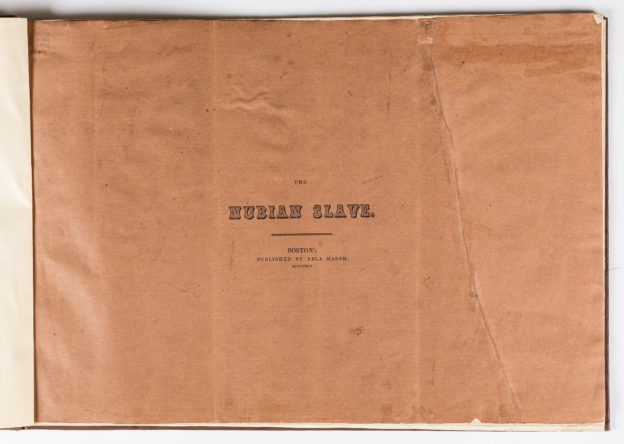
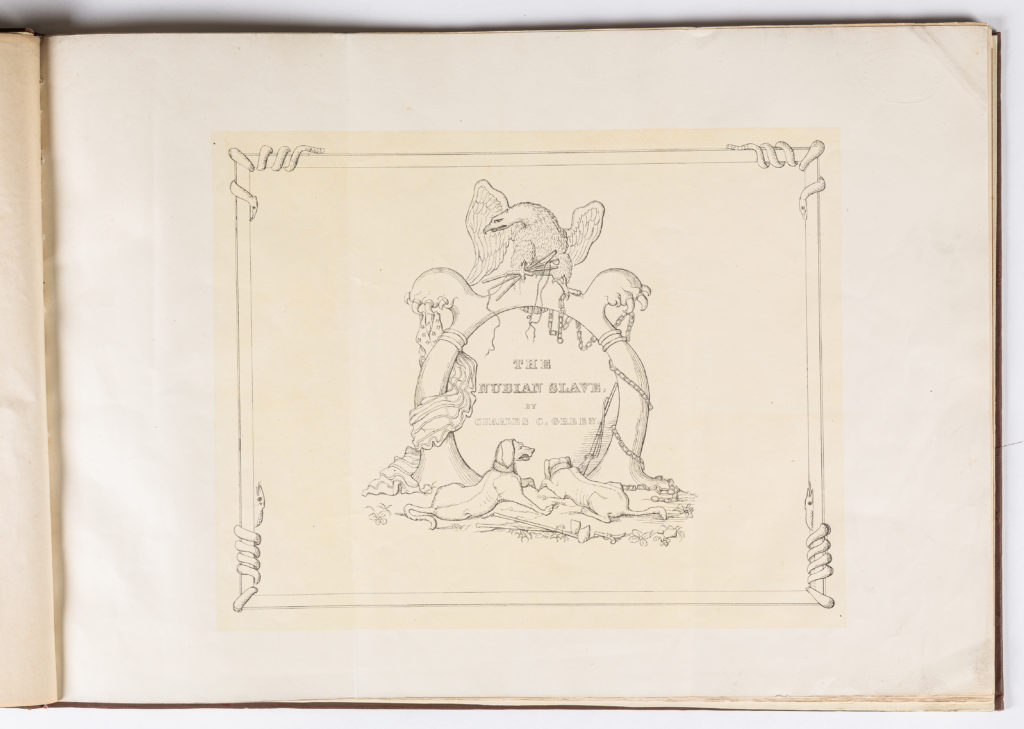
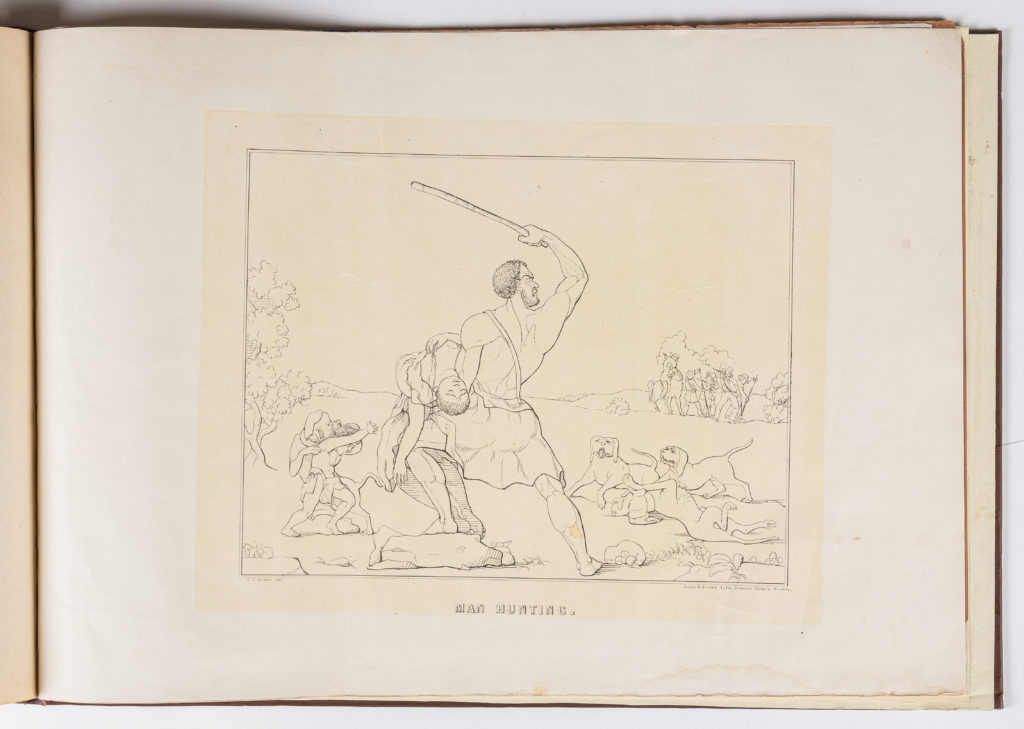

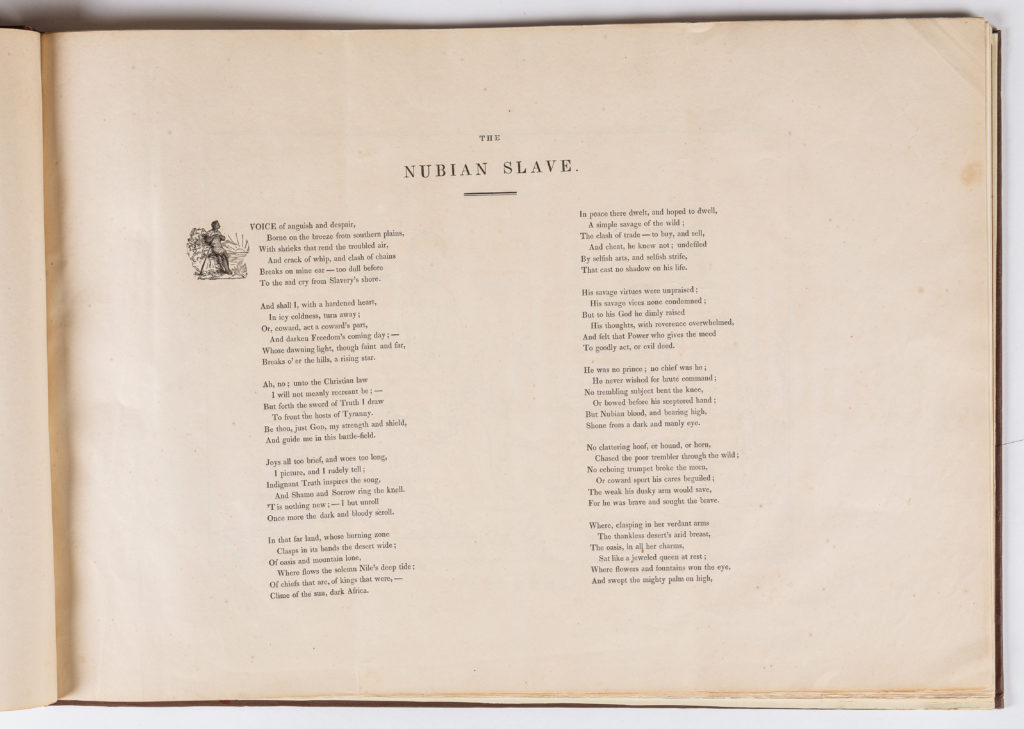
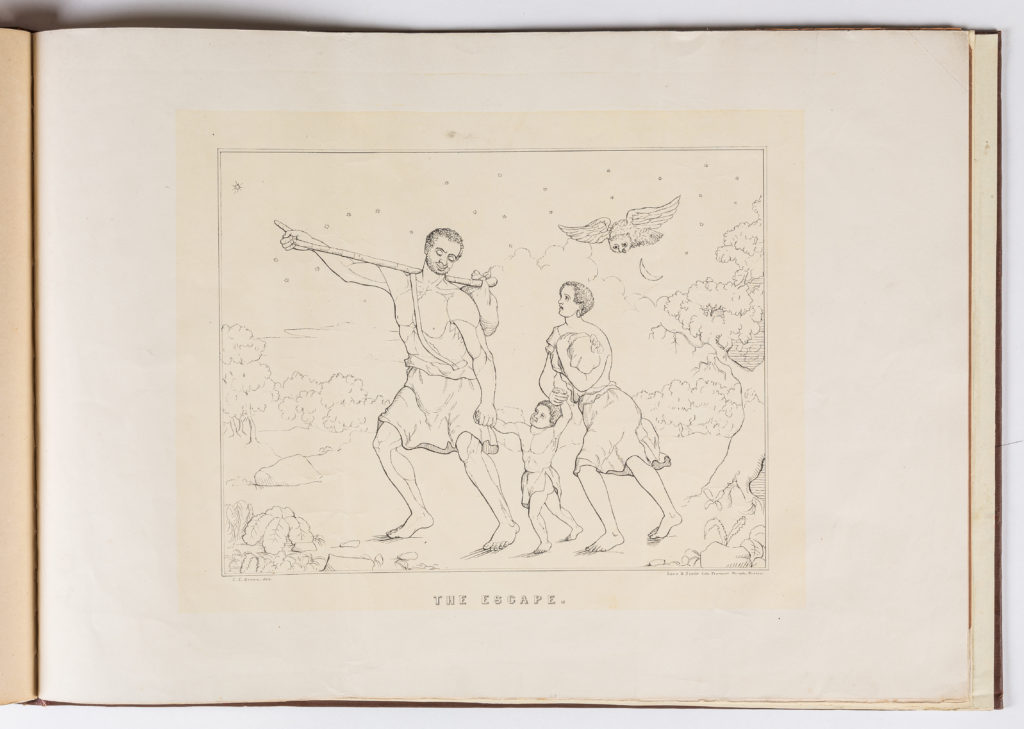
I have an original hard covered lithograph book with Charles C Greens name stamped in gold it looks like.
My grandmother gave it to me 50 plus years ago.
I have no clue what to do with it.
I happen to have two portraits by Charles Chauncey Green — one a self portrait, one of Emily Danks Green — hanging in my living room.
sarahirwin.va@gmail.com
I have two portraits by Charles C Green hanging in my living room. One is a self-portrait and the other of the artist’s wife, Emily Danks Green.